Men's Fashion During the Harlem Renaissance
Harlem Renaissance, Homosexuality, and Passing

Judith Butler
In Judith Butler's commodity Passing Queering: Nella Larsen's Psychoanalytic Claiming, she explores the homosexual ideas in Nella Larsen's novel Passing. In the novel Passing, one of the master characters, Irene hints her feelings for Clare who is the same sex as her. Throughout the novel Irene expresses not just her love, simply her desire to be Clare since she represents everything Irene is non. Clare lies throughout the novel which gives her this "sexual liberty" and passion that Irene denies herself. This results in Irene antisocial Clare because she awakens a sexual passion inside herself for Clare. Irene tries to push these feelings away by refusing to respond to her messages as well equally refusing to invite her anywhere. Another way Irene tries to make up for her feelings of desire is when she passes these feelings onto her husband, Brian. She starts to hallucinate that the two are having a secret affair behind her dorsum. These feelings come into a full circle in the last chapter where Irene is terminal seen holding onto Clare's arm equally she is either pushed or jumped out the window. If Irene did push Clare perchance this was her manner of finally getting rid of her desire for Clare. There was also the upshot of both of them existence black and the social constraints on black women'southward sexuality. Throughout the novel Irene is trapped by these social constraints of being black also equally having feeling for someone of the same sex. Mayhap the title Passing non but means to laissez passer as beingness white only for Irene it means to laissez passer her feelings she has for Clare.
Quotes that describe Irene's perception of Clare and her possible "queer" desire.
- "An attractive-looking adult female…with those dark, almost black, eyes and that wide oral cavity like a scarlet blossom against the ivory of her pare" (Larsen ix)
- "One moment Clare had been at that place, a vital glowing thing, similar a flame of cherry-red and gilt. The side by side she was gone" (79)
- "Clare exquisite, gilded fragrant, flaunting, in a stately gown of shining black taffeta, whose long total skirt lay in graceful folds almost her slim golden feet" (53)
- "Clare who suddenly clouded all her days" (65)
- "And all because Clare had a trick of sliding downwardly ivory lids over astonishing black eyes and so lifting them suddenly and turning on a caressing smiling" (66)
- "What she felt was not and then much resentment as a dull despair because she could not modify herself in this respect, could non split up individuals from the race, herself from Clare Kendry" (71)
- "The soft white face, the bright pilus, the disturbing ruby rima oris, the dreaming eyes, the caressing smile, the whole torturing loveliness that had been Clare Kendry" (80)
Irene and Brian's relationship
Brazil was a hub not only for all races but also for all sexualities. There is a possibility Brian was attracted to Brazil for both its racial freeness and its sexual openness. Likewise the fact that Irene and Brian sleep in divide rooms could show that he was not happy in their wedlock. "He slept in his room side by side to hers at dark. But he was remote and inaccessible. No use pretending that he was happy, that things were the same as they had always been. He wasn't and they weren't"(Nella Larsen pg. 68). While Irene and Brian rarely made sexual contact, Clare and Irene oftentimes touched in an affectionate nature throughout the novel.
Carl Van Vechten
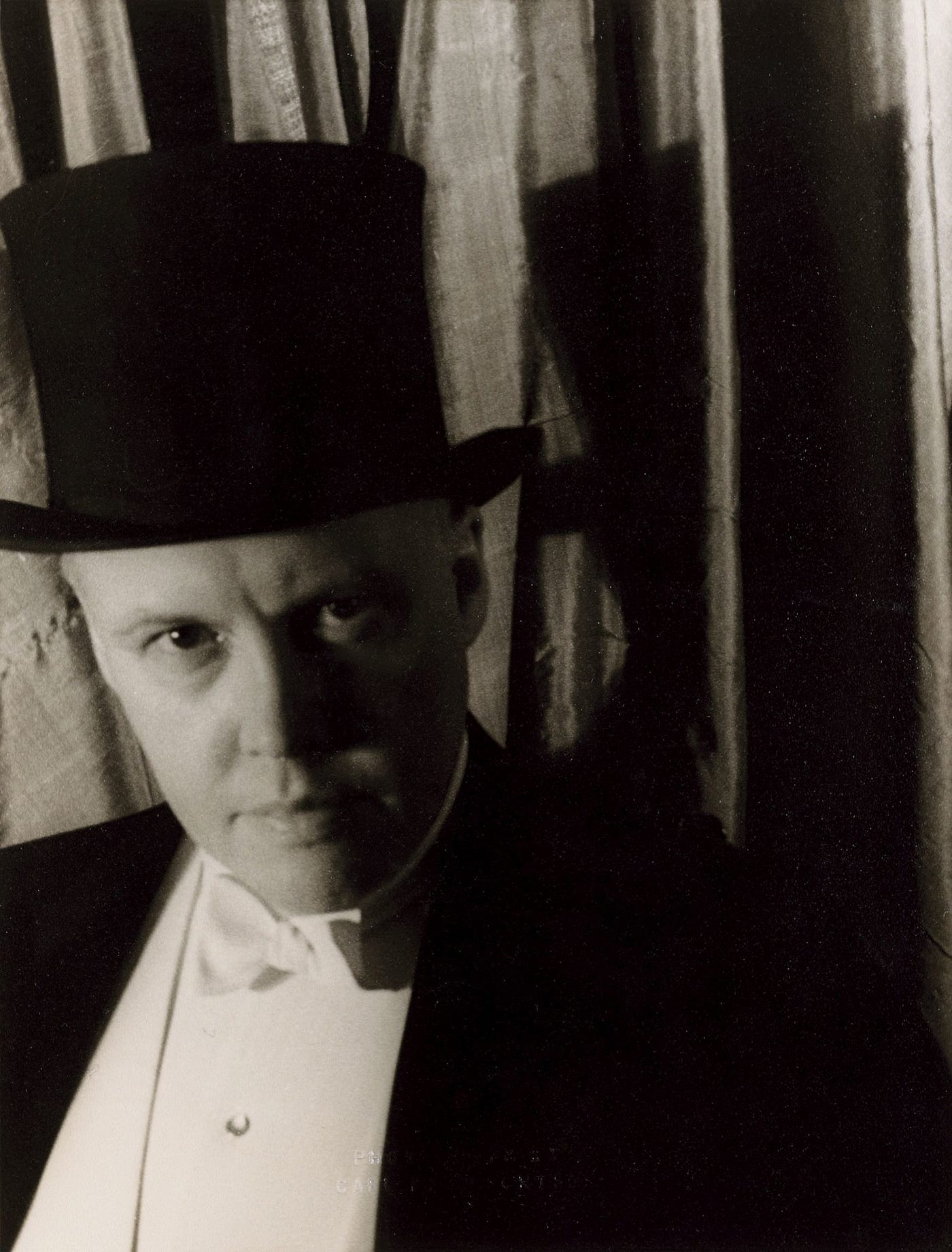
Northella Larson's character, Hugh Wentworth, is based on the white Harlem Renaissance figure Carl Van Vechten. Van Vechten began his New York career as a critic for the amusement manufacture. He became very involved with the entertainers of era, every bit well as there homosexual social circle. Information technology was there that Van Vechten formed a deep connection to the nightlife of Harlem. Van Vechten was amid many gay downtown whites who went uptown in search of sexual recreation. According to The New Yorker, he published his novel "Negro Heaven", which presented Harlem'southward African Americans as stereotypically lascivious that drew scores of white Harlem to "get slumming," many of whom were gay.
In Van Vechten'southward social life he was open almost his homosexual desire. Despite being married, he had many male lovers. Scholars accept discovered all-encompassing flirtatious behavior in letters from Van Vechten to a myriad of men. Van Vechten's married woman was distraught past the situation; she often felt equally if she had to look in line for an audition with her hubby. Richard Bruce Nugent, the first black writer to produce frank descriptions of aforementioned-sex want, remembered an odd substitution with Van Vechten, later in his life. At a party, he touched Nugent's shoulder and said, "If you had just patted me on the head and said, 'Carl, you lot're a nice boy,' yous could have had anything you wanted." Just, to Nugent, this seemed less like a suggestion and more than similar an older man'southward plea for acknowledgment (The New Yorker)."
Homosexuality during the Harlem Renaissance
The Harlem Renaissance can be characterized by a movement of African American arts and civilization. Historians state that this era tin be defined by both race and sexuality. According to an commodity from The New Yorker, "The Harlem Renaissance was, in Henry Louis Gates's formulation, "surely every bit gay as information technology was black". There was a growth in art, jazz and blues, and elevate balls. This time period was defined as "homosexual mecca" or queer paradise. Ane of the most popular attractions was Green Which Village where homosexuals found freedom (Sherouse, Glenda Elizabeth).
The 1931 novel Foreign Brother, by Blaire Niles, sums up the period's complicated social geography best: "In Harlem I found backbone and joy and tolerance," notes ane gay character. "I tin be myself in that location … They all know about me, and I don't accept to lie." Harlem provided refuge because it had no separate customs based on shared sexual orientation. Scholars accept said that during the 1920s and 30s, Harlem had one of the nigh vibrant queer communities of color in the 20th century. During this fourth dimension artist were forced to either retire or hide their sexual preference. Jazz Age Harlem offered a combo of license and sexual ambiguity that provided a comfortable surroundings for those attracted to members for their own sexual practice (Villarosa, Linda).
Despite this kind of freedom and pageantry, homosexuality wasn't universally accepted. Harlem's most powerful minister, Adam Clayton Powell, pastor of the Abyssinian Baptist Church until 1937, campaigned confronting what he saw as the growing scourge of sexual perversion and moral degeneracy. The annual Hamilton Order event where homosexuals would come together and dress in drag, was openly referred to as the "parade of the pansies," "trip the light fantastic of the fairies" and "faggots' ball."
Homosexual Performers from the Harlem Renaissance include Bessie Smith, Ma Rainey, Alberta Hunter, Jackie "Moms" Mobley, Josephine Baker, Alain Leroy Locke, Bruce Nugent, Wallace Thurman, Ethel Waters, and Madam C. J. Walker who is said to have had affairs with women, and was instrumental in bringing about the acceptance of gays in Harlem social circles.
The Blues, Homosexuality, & Harlem Renaissance

As it turns out, the blues world was the perfect realm for people who were idea of as "sexual deviants" to reside, in part because people in the entertainment industry had far more leeway to flout sexual mores. Blues music also thrived far outside the telescopic of the ascendant white American culture in the early on 20th century. During the Jazz age there was speakeasies, swoop bars, and individual parties where blues singers had the freedom to explore culling sexuality, and on a rare occasion, they fifty-fifty expressed it in song. Information technology's likely that the flapper movement took some cues from these dejection divas, who were on the cutting edge of that sexual revolution during the 1900s which consisted of conventions about proper women left and right. Gertrude 'Ma' Rainey who is known equally the Mother of the Blues, hinted at her sexuality in her lyrics, "It's true I wear a collar and a tie. . .Talk to the gals but like whatever old homo" and Bessie Smith, a married woman who kept a female lover, also sang "When you come across 2 women walking hand in paw, only await 'em over and try to understand… They'll become to those parties — accept the lights downwards low — only those parties where women can go"(Peppers, Margot).
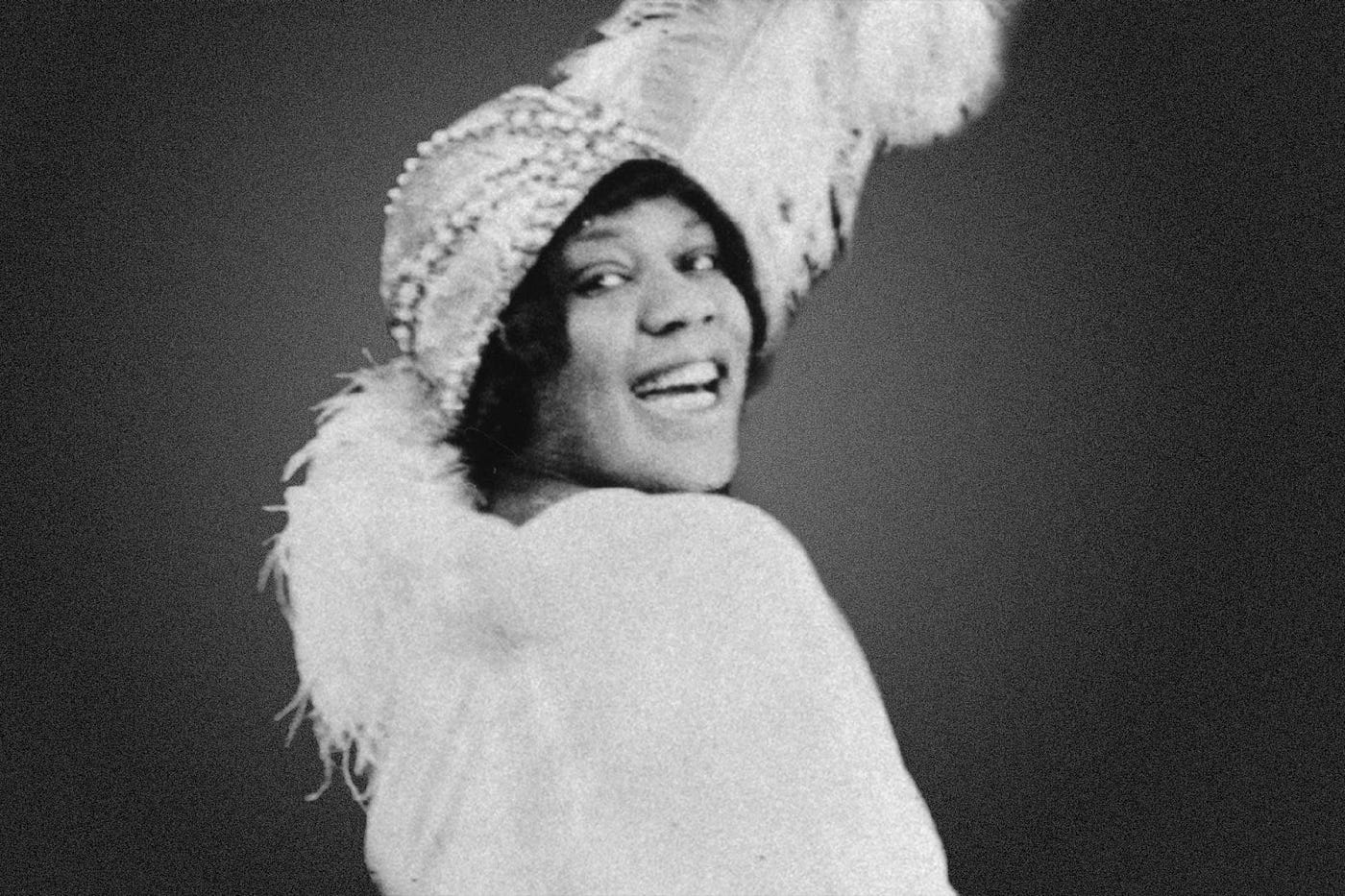
Laws from:The Politics of Homosexuality In the Twentieth Century of Black Freedom Struggle
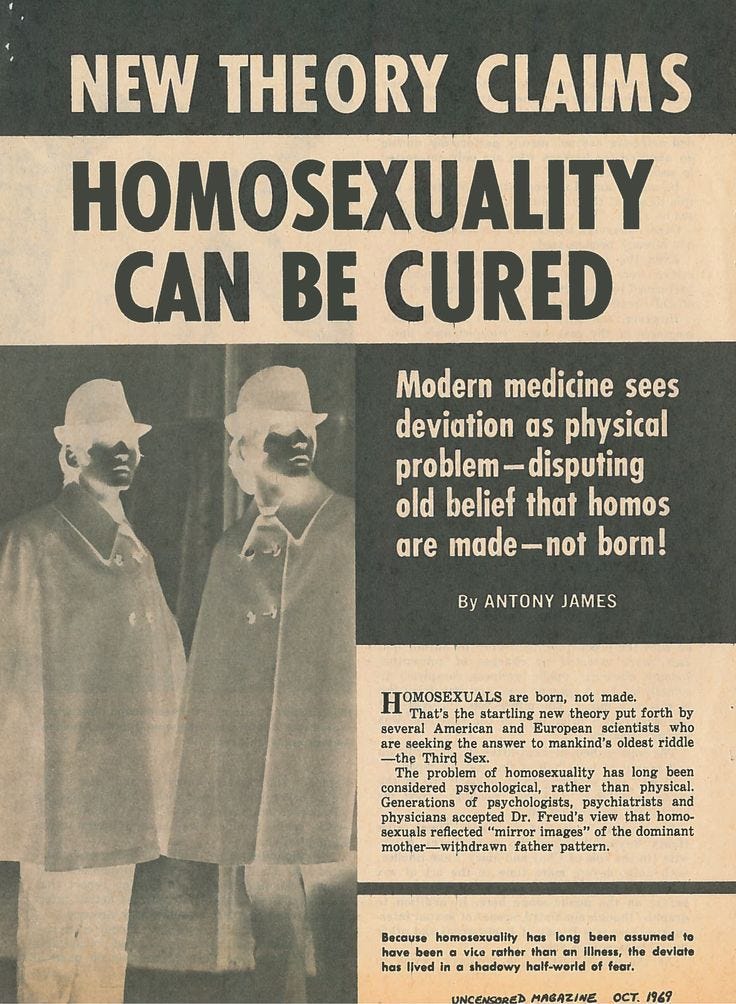
Antisodomy laws and others modeled after British statutes banning "crimes against nature", had been in result across America since colonial days (Gay 30's). Conservative laws regarding sexual behave began to appear in the thirty's. There was also an emergence of both laws and attitudes that sought to define proper middle-course blackness masculinity and femininity in strictly heterosexual terms.
During the Jim Crow era, southerners viewed homosexuality equally wrong and information technology was treated as another form of black sexual deviance. There was a not an official term for a person who good homosexuality in the 20's and xxx'southward. Therefore, scholars referred to them as "indeterminate", "third sex", or "degenerate". This era was the beginning of modern queer black culture and the ancestry of anti-homosexual attitudes within black communities.
Queer sexuality represented another possible source of arguments for black inferiority and exclusion from citizenship. This intensified during the decades as African American's increasingly came to embrace white middle-grade ideas about gender and sexuality every bit a means of strengthening their arguments for access to total citizenship rights. For African Americans that belonged to or wished to be autonomously of the eye grade in Harlem, suffered immensely if they were non heterosexual. This was because homosexuality carried bigger consequences than information technology did for working form blacks (Sherouse, Glenda Elizabeth).
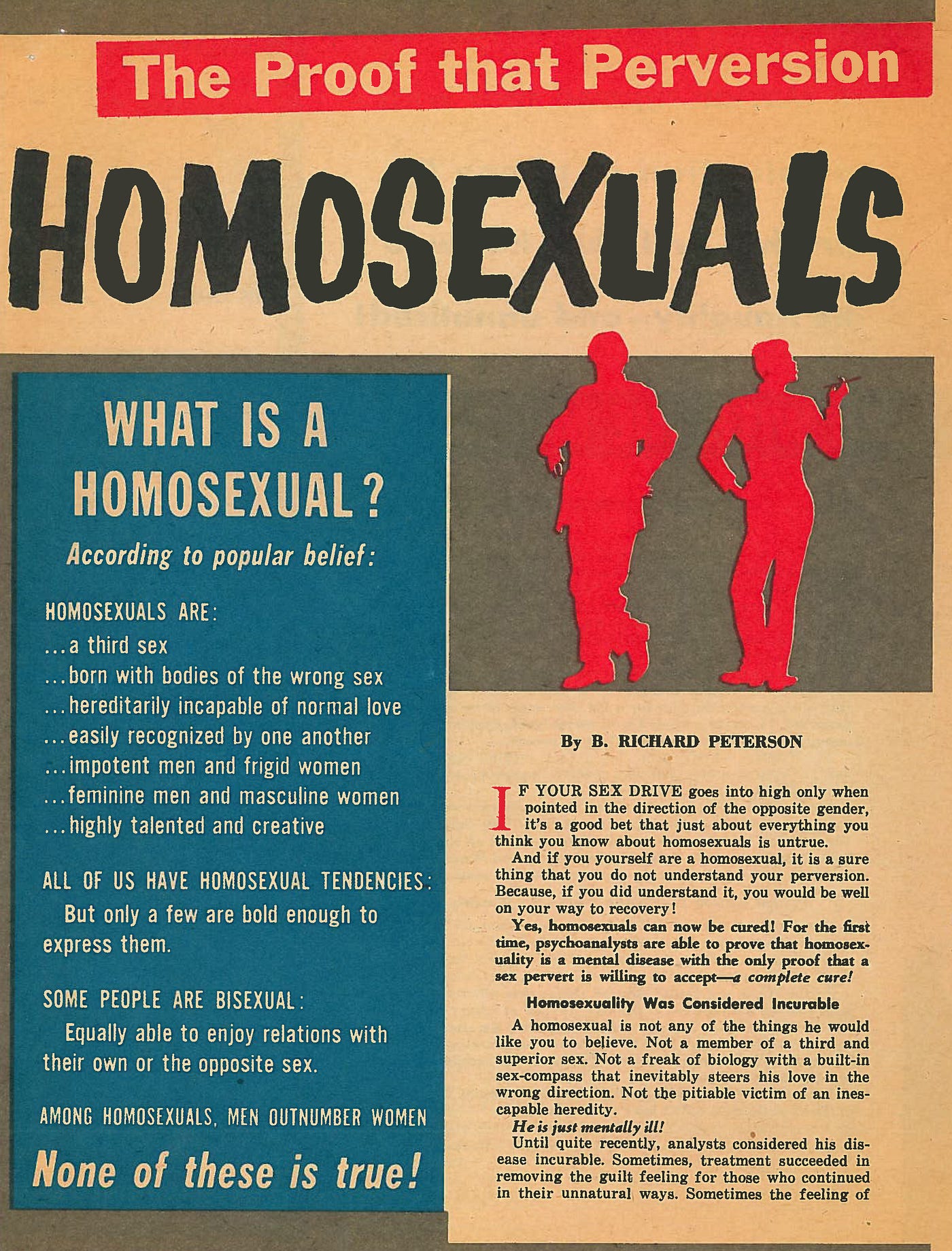
Lesbian dejection singers had to appear bisexual at least in their public epitome. Blues Singer Ma Rainey got into problem with the constabulary for her lesbian beliefs in 1925, she was arrested for taking office in an orgy at her dwelling involving the women in her chorus. She was charged with running an indecent party. A large migration of southern African Americans eventually left to head toward the north, more specifically New York Metropolis. There was sexual freedom peculiarly in Greenwich Hamlet which was famous for its gay community because "it was the only identify where black men could congregate in commercial establishments" making it the center of black gay life in the urban N (George Chauncey).
Gay Nightlife in the Harlem Renaissance
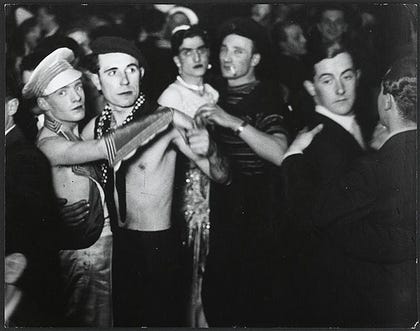
Nightlife was a very important element of gay culture. The suppression of the era drove people in search of gay interaction to the furtive nighttime guild scene. The gay nightlife can exist identified past three different scenes: rent parties, buffet flats, and drag balls.
There was an intense increment in public homosexuality following the Prohibition. The Pansy Craze, of both Chicago and Harlem, was a surge of popularity for gay performers. "African American elevate entertainers performed for racially mixed audiences at some of the South Side'south virtually famous 'black and tan' [cabarets]. Mexican 'queers' carved out a space for themselves along Ashland Artery, and ethnic working-class 'queens' from the metropolis's North, South, and West Sides met at private parties and public drags throughout the urban center (Blackmer)."
The Entertainment Industry became a prophylactic place for homosexuals to make social connections. The blues music industry rapidly became a hub for lesbian entertainers. These artists even occasionally expressed their homosexual desires in their music. The dejection adult female were forerunner to the flapper generation divers by sexual freedom.
It was non only those practicing homosexuality that partook in the nightlife scene. Many bystanders came to observe the "sexual deviants." This civilization declined chop-chop following the Stock Market Crash of 1929 and the beginning of the Groovy Depression.

Drag balls took identify at the Rockland Palace Savoy. Men would apparel as women and women would dress as men. Males would wear flowing gowns and feathered headdress's and females would appear in tuxedos and box black suits. For the men, at that place was also a fashion parade. There was too prizes which were given to the most gorgeously gowned of the whites and negroes who, powdered, wigged, and rouged, and competed for awards. People came from Boston, Philadelphia, Pittsburgh, and Atlantic city to nourish. The show was presented by other former "queens" of the brawl, prize winners of years gone by wearing the costumes that won them their prizes. The costume balls, parties, speakeasies and buffet flats of Harlem provided an arena for homosexual interaction, only not for the evolution of homosexual networks. I area where blackness lesbians and gay men found particular bonds of friendship was within Harlem's entertainment earth.
Race and Sexuality in the Harlem Renaissance
One thousandeographically, Harlem was located conveniently for white New Yorkers: African Americans lived "also far away to be dangerous yet close plenty to be heady." Those white visitors in search of sexual and homosexual adventures had less reason to fright social ostracism or the loss of family unit ties and employment, every bit they could retain a sexually inconspicuous image in their everyday white environment (Schwarz).
E. Franklin Frazier points out that the black middle form has "striven to mold themselves in the image of the white homo" — an aspiration which to some extent implies attempts to emulate the "best" white Americans in terms of looks, taste, morality, and value system. A more accurate analysis seems to exist that the black suburbia sought respectability. African Americans had been portrayed and treated as sexually suspicious and excessive in the form of sexless "darkies" and "mammies" or oversexed studs" and "Jezebels." The blackness bourgeoisie aimed at sexual "normality" by means of an adherence to college moral standards that whites, who had the power to ascertain respectability, had denied them for centuries. This may be why Irene seems to be fixated on Clare whenever they are together, but also tries to avoid Clare at every opportunity; she tries to hibernate her want for Clare in social club to maintain her respectable office equally a mother, wife, and leader in her community.
Hazel Carby notes the emergence of "fears of a rampant and uncontrolled female person sexuality… and fears of the assertion of an independent blackness female desire that has been unleashed through migration." The fact that migrant women were frequently unmarried meant that they not only stood exterior a family construction, regarded equally key to blackness America's "racial uplift," but also seemed to reject the role of motherhood. (Schwarz)
Lesbians were viewed as particularly deviant. Co-ordinate to bell hooks, the "prevailing assumption was that to be a lesbian was 'unnatural' because i would not be participating in child bearing." In the milieu of Harlem, Schwarz notes, gay men were slightly more than acceptable than lesbians. (Schwarz)
Concerns virtually female sexuality were mainly voiced in black middle form circles, but a woman's pick of a female person sexual partner was presumably equally perceived every bit a serious threat in a black working grade environment. In this social context, lesbians were, evoking an "inverted," masculine paradigm, derogatorily known as "bulldaggers" or "bulldykers." Significantly, their gender part inversion seems to take met with far less favorable reactions than that of their male counterparts, the fairies. While this is non to imply a sympathetic treatment of fairies, information technology seems that, for instance, in newspaper reports on elevate balls, cross-dressing men were favored: Fairies and their elaborate costumes were often described in detailed, long columns as "gorgeous beyond words," whereas cantankerous-dressing women were mentioned only briefly, if at all. While their costumes were certainly fundamentally dissimilar and men'south clothes, equally could be argued, can only to a limited extent be admired for their fabrics or colors, it is noteworthy that unremarkably any tone of admiration is defective in the description of cross-dressing women. They appear to be implicitly blamed for their lack of colors and elegance, or, in short, their lack of femininity.(Schwarz)
Gladys Bentley
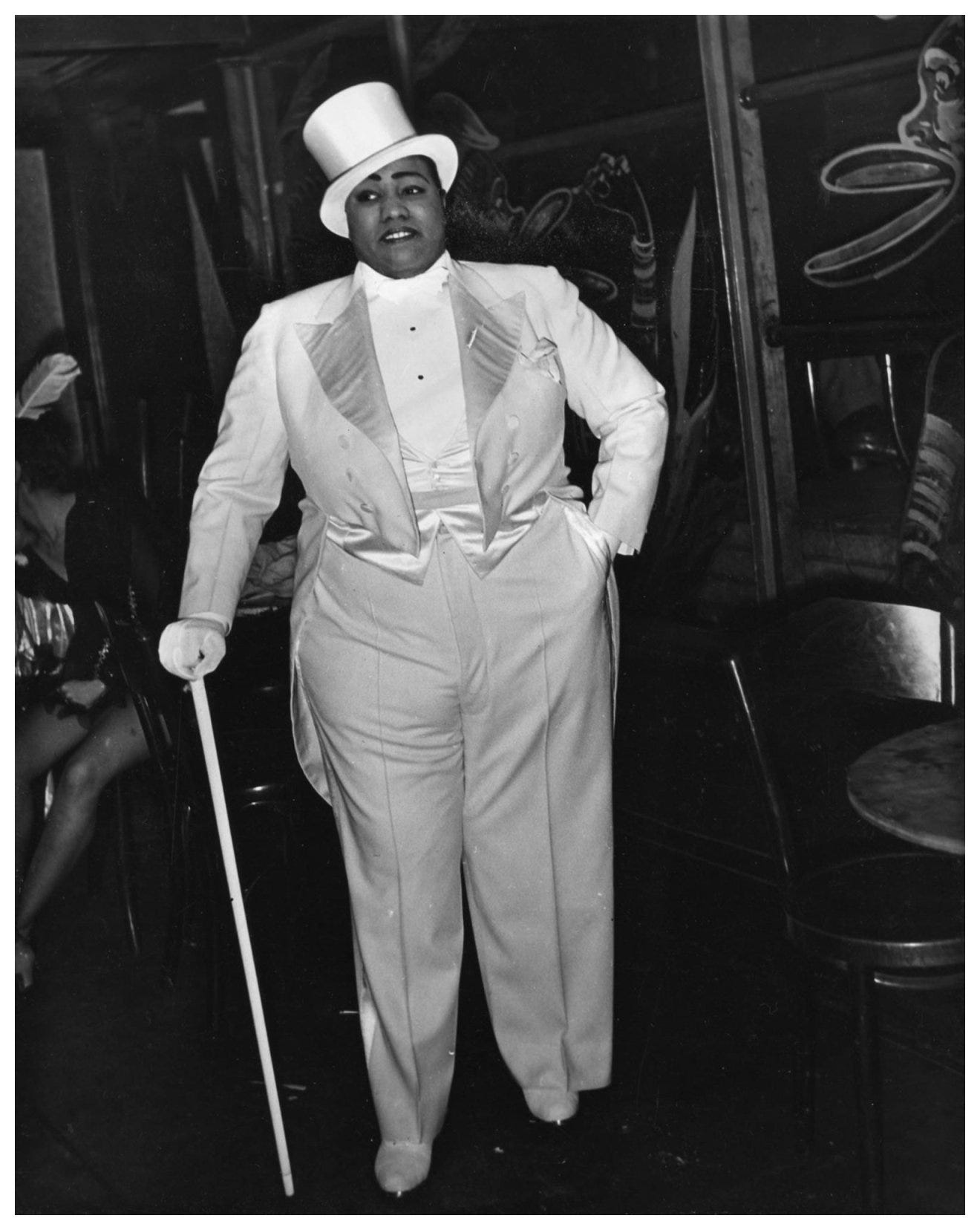
Bentley thrived during the Black Renaissance in Harlem during the '20s and early '30s, condign unquestionably Harlem's favorite "bulldagger." Wearing box ties, Eton jackets, and curt direct hair, Gladys created a sensation wherever she went. She expressed her inventiveness and her sexuality flourished free from prejudice or scrutiny past either the White or African American community. Unfortunately, this all-too-cursory period of freedom concluded by the close of the 1930s. Homophobia, uniting with racism, sexism, and classism, destroyed Bentley'due south ability to live creatively and freely (Wilson).
On top of existence an African American, Gladys was a woman. Her race, gender, and sexuality triply marginalized her in the eyes of the white, heterosexual, masculinist world. She had no place to hide from homophobic or sexist attitudes. Dissimilar many of her white lesbian and gay counterparts, she couldn't retreat backside a facade of white and heterosexual normalcy. The open up and accepting environment of Gladys's friends melted back into the closet. Gladys's overt sexuality and public persona, all the same, prevented her own retreat. Gladys lost her financial support when her sexuality and race became an outcome. In the end, she had to cede her sexuality for survival (Wilson). Considering Irene does not pass in her community, she can't take chances having a human relationship with Clare, who tin pass. Irene would be too ostracized for being both black and a lesbian, unlike Clare, who would be able to hibernate behind the facade of beingness white.
Glossary
Chicago'south shadow homosexual earth of the 1930s was so well adult that participants devised their own cant. The use of the word "gay" did not become popular until the 1940s and 50s. Professor Ernest West. Burgess compiled a "Glossary of Homosexual Terms."
Auntie — Older queer, or one who acts old
Belle — Any homosexual person; ane who is usually aware of his condition
Bitch — Term for homosexuals, usually amongst themselves
Blind — Homosexual traveling with a girl, or who marries to conceal his condition
Brownies- gay man, term from Philadelphia
Bulldagger- a masculine adult female
Chorus moll — Type of young homosexual who is effeminate, uses rouge, lipstick, dresses foppishly
Dirt — Persons, oft merchandise, who bribery or rob homosexuals. Usually picked up in public places
Faggot — A gay homo
Fairy — A gay human being
French — Fellatio
Dark-green — Homosexual who is ignorant of his condition; average person who is ignorant of homosexuality
Marjorie — Homosexual who is affected, flirty, very effeminate, "sugariness and lovely"
Miss Lesbos — Term practical to lesbian daughter
Party — Sexual act; usually involves fellatio
Sissy — a feminine male
Tea room — Public toilet
Trade — 1 who volition permit homosexuals to have sexual relations with him, ordinarily for money
Rent Parties — known for their wild, sexually charged atmosphere, and bootleg liquor.
Queer — A person with homosexual tendencies
Buffet flats — apartments converted into sex clubs that featured shows and prostitution.
Works Cited
American Studies @ The University of Virginia, xroads.virginia.edu/~ug97/blues/garber.html.
Clayton, Joana. "Cupboard Ain't Nothin' merely a Night and Private Place for . . . ?." ["text of performance piece"]. Fine art Journal, vol. 55, Winter96, pp. 51–54. EBSCOhost, doi:10.2307/777654.
Blackmer, Corinne E. " The Veils of the Law: Race and Sexuality in Nella Larsen's Passing ." The Johns Hopkins Academy Printing, www.jstor.org/stable/pdf/25112208.pdf?refreqid=excelsior:9b2f76b35a3864222a91deee46709d1cwww.chicagomag.com/Chicago-Mag/November-2005/The-Gay-30S/.
Fleeson, Lucinda. "The Gay '30s." Chicago Mag,
world wide web.chicagomag.com/Chicago-Magazine/November-2005/The-Gay-30S/.
Garber, Eric. "A Spectacle in Color: The Lesbian and Gay Subculture of Jazz Age Harlem."American Studies @ The University of Virginia, xroads.virginia.edu/~ug97/blues/garber.html.
Hix, Lisa. "Singing the Lesbian Blues in 1920s Harlem." Collectors Weekly, world wide web.collectorsweekly.com/articles/singing-the-lesbian-dejection-in-1920s-harlem/.
Larsen, Nella. Passing. Penguin Books, 2003.
Peppers, Margot. "The Lesbian Blues Singers of 1920s Harlem: How Speakeasies and Underground Jazz Bars Became a Home-from-Habitation for New York's 'Sexual Deviants'." Daily Mail Online, Associated Newspapers, 12 July 2013, world wide web.dailymail.co.u.k./femail/commodity-2360792/The-lesbian-blues-singers-1920s-Harlem-How-speakeasies-surreptitious-jazz-bars-home-home-New-Yorks-sexual-deviants.html.
"Renaissance in Harlem." Out of the Past: Gay and Lesbian History from 1869 to the Present, past
Neil Miller, Alyson Publications, 2006, pp. 135–143.
Sanneh, Kelefa. "White Mischief." The New Yorker, The New Yorker, 18 June 2017, www.newyorker.com/magazine/2014/02/17/white-mischief-ii.
Schwarz, A.B. Christa, et al. "Gay Voices of the Harlem Renaissance." By A.B. Christa Schwarz,
world wide web.goodreads.com/book/prove/1106683.Gay_Voices_of_the_Harlem_Renaissance.
Sherouse, Glenda Elizabeth. "The Politics of Homosexuality In the Twentieth Century Blackness
Freedom Struggle." Academy of Due south Carolina Scholar Eatables, 2013, https://scholarcommons.sc.edu/cgi/viewcontent.cgi?referer=https://www.google.com/&httpsredir=1&commodity=2478&context=etd
Villarosa, Linda. "The Gay Harlem Renaissance." The Root, Www.theroot.com, 23 July 2011,
www.theroot.com/the-gay-harlem-renaissance-1790864926.
Wilson, James F. Bulldaggers, Pansies, and Chocolate Babies : Performance, Race, and Sexuality in the Harlem Renaissance. University of Michigan Press, 2010. Triangulations. EBSCOhost, athena.rider.edu:6443/login?url=https://search.ebscohost.com/login.aspx?directly=truthful&db=e000xna&AN=1527078&site=eds-alive&scope=site.
0 Response to "Men's Fashion During the Harlem Renaissance"
Post a Comment